Quartic surface.
| next surface | previous surface | 2D curves | 3D curves | surfaces | fractals | polyhedra |
GOURSAT SURFACE
| Family of surfaces studied by Goursat
in 1887.
Edouard Goursat (1858 - 1936): French mathematician. |
| Cartesian equation: Quartic surface. |
The (octahedral - best to avoid "cubic") Goursat surfaces
are the quartic surfaces that have the symmetries of the cube
(or, which amounts to the same thing, the octahedron).
More precisely, they are the quartics such that the isometry
group under the action of which they are invariant is the same as that
of the cube.
The general form in Cartesian coordinates is given above.
Some remarkable special cases:
| View obtained with Maple | (k, k', k") | Equation, comment | Povray view, by Alain Esculier |
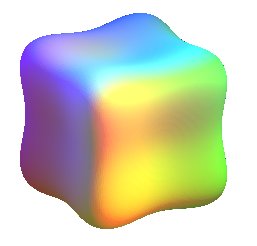 |
(0, –1, 0) | Rounded cube passing by the vertices |
|
|
|
(–1,–1/4,1/4) | Rounded octahedron passing by the vertices |
|
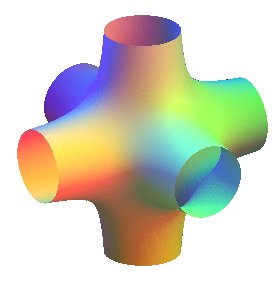 |
(–1, 1, 1) | ||
| (0, –2, 2) | Surface with 12 singularities |
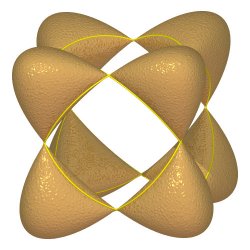 |
|
|
|
(–1/2, -1, 1/2) |
Surface containing the 12 extended edges of the octahedron: It is to the octahedron what the Cayley surface is to the tetrahedron. |
|
|
|
(–1/2, 1, -3/2) |
Surface containing the 12 diagonals of the faces of the cube It is to the cube what the previous surface was to the octahedron. |
 |
| (–1, 4, –6) | Surface containing the 12 extended edges of the cube
|
||
|
|
Same surface as before! |
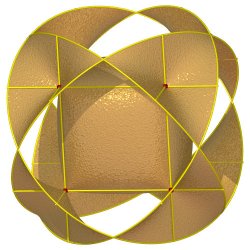 |
|
|
|
(–1, 2, –2) | Surface with 12 singularities |
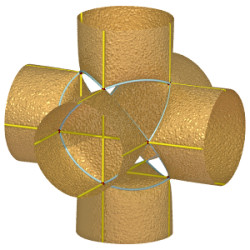 |
|
|
(-1/3,-2/3,2/3) |

Surface with 12 singularities |
| Animation of the case |
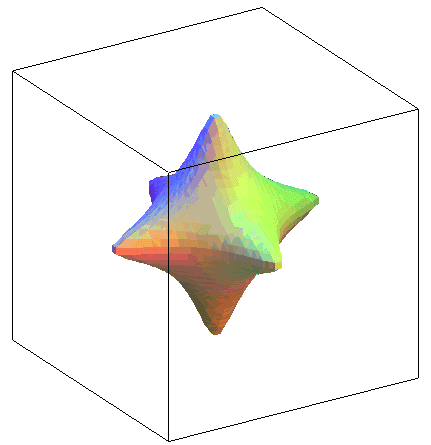 |
|
More generally, the Goursat surfaces are the algebraic surfaces with the symmetries of a regular polyhedron, the simplest after the sphere.
The general equation of the tetrahedral
Goursat surfaces, of degree 3, is: .
For k' = 0, we get the Titeica
surface;,
and in the other cases, up to changing a into a/k', we can
assume k' = 1, and we get the family with one parameter
that behaves as follows:
| k < 0, k = 0
Four sheets, plus, in the case k = 0, the isolated point O. |
0 < k < 4
A rounded tetrahedron plus 4 sheets. |
k = 4
Cayley surface |
k > 4 |
| Views of the quartic with equation
that has the symmetries of the tetrahedron (notice the 4 "triconical" points, |
 |
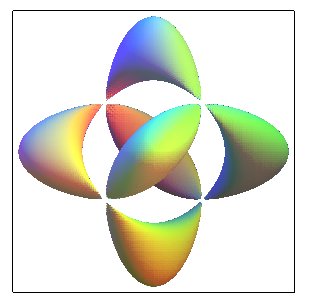 |
The general equation of the dodecahedral Goursat surfaces, of degree 6, is:
Some remarkable special cases:
| (k, k',k",k''') | Equation, comment | ||
|
|
(0, 0, 0, 0) |
i.e. Surface that decomposes into the 6 planes passing by the edges of an icosidodecahedron (the plane z = 0, the plane z = 2x and its 4 images by rotations of |
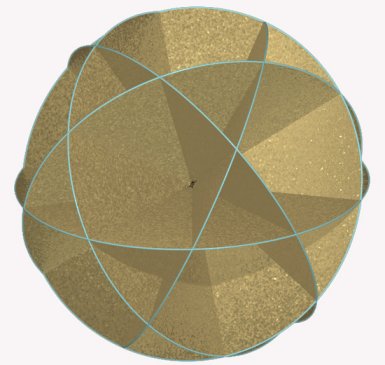 |
|
|
(1,–1,1,–1) | Rounded dodecahedron. |
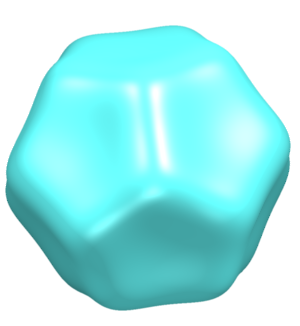 |
|
|
(–1,0,–1,1) | Rounded icosahedron |
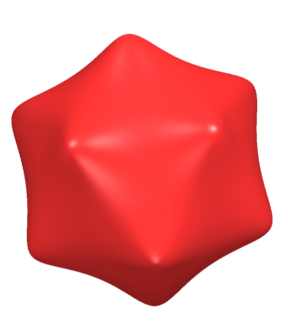 |
|
|
(0,1,–2,1) | Surface with 30 singularities at the vertices of an icosidodecahedron. It is composed of 20 sheets with bases the triangular faces of the icosidodecahedron. |  |
|
|
(0,–1,2,–1) | Surface with 30 singularities at the vertices of an icosidodecahedron. It is composed of 12 sheets with bases the pentagonal faces of the icosidodecahedron. | 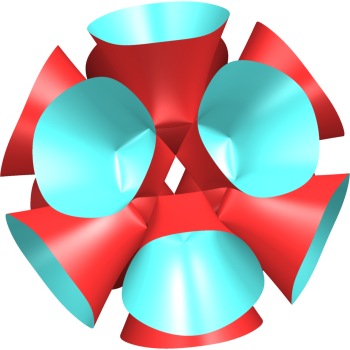 |
|
|
(0,5/4,–5/2,5/4) | Barth sextic, with fifty singularities. | 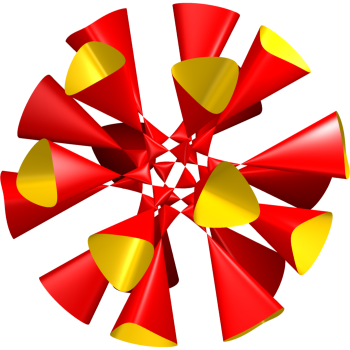 |
| We can impose on the surface of equation given above
to contain a line not passing by O, and we then note that the surface
has exactly 60 lines, images of one of them by the 60 rotations of the
group of isometries of the dodecahedron.
For example, the value of (k, k ', k ", k''') for the surface to contain the line x = -2z, y = a is (-1, 8, -18, 11); in this case, the lines are grouped in 6 groups of 10 parallel lines forming six cylinders whose axes are those which join the opposite vertices of a regular icosahedron. |
 |
See other superb Goursat sextics in relief on this page of Alain Esculier.
See also the Goursat curves, the surfaces invariant under the action of a half-turn, the surfaces with rotational symmetry.
Goursat surfaces, by Patrice Jeener
| next surface | previous surface | 2D curves | 3D curves | surfaces | fractals | polyhedra |
© Robert FERRÉOL
2017